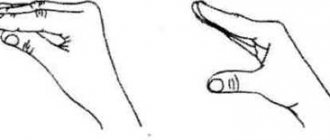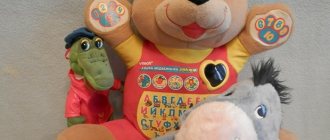Progress of the game:
Children take turns stroking their fingers , first on one hand and then on the other hand.
Finger - boy , where have you been? (Stroke the thumb)
I washed my brothers on the river. (Wash hands)
I went to the forest with this brother, (Stroke the index finger)
I cooked cabbage soup with this brother, (Middle finger)
I ate porridge with this brother, (Ring finger)
I sang songs with this brother. (Little finger.)
October
"Where are the pens"
Goal: Activate finger .
The benefits of finger exercises for children
The goal of finger gymnastics is to develop dexterity and accuracy of the fingers, develop the relationship between the hemispheres of the brain and synchronize their work.
In the right hemisphere of the brain we have various images of objects and phenomena, and in the left they are verbalized, that is, they find verbal expression, and this process occurs thanks to the “bridge” between the right and left hemispheres. The stronger this bridge, the faster and more often nerve impulses travel along it, the more active the thought processes, more precisely the attention, the higher the abilities.
If you want your child to speak well, learn quickly and easily, and deftly perform even the most delicate work, start developing his hands: fingers and hands from an early age. This is exactly what finger gymnastics for children helps.
Finger games can be said to be an excellent universal, didactic and developmental material. The methodology and meaning of these games is that the nerve endings of the hands affect the child’s brain and brain activity is activated.
Finger gymnastics will help prepare a child’s hand for writing and develop coordination. Thanks to such gymnastics, the child receives a variety of sensory impressions, he develops attentiveness and the ability to concentrate.
Also, such games form the relationship between an adult and a child.
Progress of the game:
Magpie - forty (the index finger of the right hand is performed
She cooked porridge, moving the palm of her left hand. Actions
She fed the children. accompanied by words, bend our fingers
Gave this one, (Little finger)
Gave this one, (Unnamed)
Gave this one, (Medium)
Gave this one, (Index)
I gave it to this one. (Big.)
“Like our cat”
Goal: Learn to perform game tasks, develop fine motor skills.
Target
Scientists have found that correct speech
The child is completely dependent on the development of fine
motor skills.
The fingertips contain a huge number of nerve endings that send signals to the brain. Therefore, the more accurately and coordinatedly the hands perform movements, the better speech abilities and other skills are formed.
The main tasks of finger games for children
:
From 6 months - 2 years.
- Brain activation
the main centers responsible for the ability to speak. - Such gymnastics
stimulates the baby to imitate adults.
From an early age,
a child learns to understand others. - The child gains the ability to follow an object.
- An understanding of the rhythm of movements develops.
From 3 – 5 years.
- Learning to concentrate.
- Memory development.
- Activation of the thought process.
- Relieving physical and emotional stress.
From 5-6 years.
- Formation of creative abilities.
- Hand exercises are necessary for the ability to write during school learning.
- Improving motor coordination skills.
- Development of imagination and the ability to think outside the box.
On a note!
Only by the age of is a child able to learn to perform hand movements like an adult.
With the help of finger games, the baby learns to quickly switch attention, which promotes mental development. It is important to carry out the exercises in stages, and also to select activities in accordance with the age of the baby.









